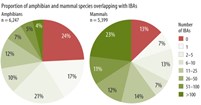
In countries in which both Important Bird Areas (IBAs) and globally important sites for other wildlife have been identified, IBAs represent 71% of the number and 80% of the area of important sites for all these taxa. Furthermore, the global IBA network overlaps with the distributions of 76% of all amphibian and 87% of all mammal species. IBAs are therefore critical for the conservation not just for birds, but for biodiversity more broadly.

In countries in which both Important Bird Areas (IBAs) and globally important sites for other wildlife (mammals, amphibians and certain reptile, fish, plant and invertebrate clades) have been identified, IBAs represent 71% of the number and 80% of the area of important sites for all these taxa (Butchart et al. 2012). Furthermore, the global IBA network overlaps with the distributions of 76% of 6,247 amphibian and 87% of 5,399 mammal species (including 72% of threatened amphibians and 79% of threatened mammals). IBAs also cover 86% of 825 terrestrial ecoregions and 84% of 232 marine ecoregions. IBAs are therefore critical for the conservation not just for birds, but for biodiversity more broadly (analysis of BirdLife data 2013).
References
Compiled: 2013
Recommended Citation:
BirdLife International (2013)
IBAs are vital for many other kinds of biodiversity.
Downloaded from https://datazone.birdlife.org/ibas-are-vital-for-many-other-kinds-of-biodiversity on 26/12/2024